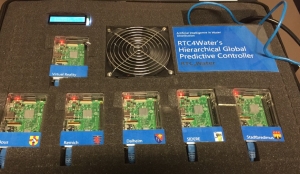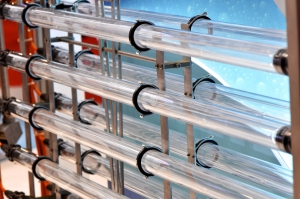RTC4Water selected by global water technology innovation group to present their fully autonomous water network optimisation system at this year’s Aquatech Amsterdam trade fair
RTC4Water, a pioneer in the development of a new breed of artificial intelligence software systems for water and sewer distribution networks, will present the latest in predictive and autonomous software systems from October 31st to November 3rd at Aquatech Amsterdam; one of the world’s leading trade exhibitions for water technology professionals. RTC4Water develops software systems which optimize water and wastewater (sewer) networks. By applying the latest technologies from the software development and automation domains, water and sewer network administrators can now achieve a higher level of efficiency which would typically not be possible with human operators. “We are extremely excited to be selected by BlueTech Research to present the newest advances in water distribution control. It is a recognition of our team and all water providers here in Luxembourg, who together have developed a world leading solution to tomorrows water problems” said Alex Cornelissen, one of the founders of RTC4Water. As part of its participation in Aquatech’s innovation activities, RTC4Water will showcase a new technology designed to model and optimise the behaviour of multiple water distribution networks which are managed by different communities and who may have diverse water utilization goals. This new technology builds upon RTC4Water’s successful Global Predictive Controller™ system which has given small to medium-sized communities the ability to reduce water supply costs while improving water quality.
For those planning to attend this year's trade fair, please stop by our stand in Hall 7, Section 550 to see our work and share with us your thoughts and ideas.
Optimizing Bacteria Elimination with RTC4Water’s Limited Continuous Actuator™
The benefits of UV disinfection on bacteria levels are well known and many communes in Luxembourg incorporate UV-systems at the intake of their water distribution networks. However, many of these systems are in the process of being upgraded and are now often fitted with flow control valves. One of our clients recently asked us how our Global Predictive Controller™ (or GPC) network optimization software would impact the operation of their water inlet, which was now equipped with a flow control valve and a UV system. Their request was to find a way to only use the UV system when a sufficient flow rate was demanded – and then turn it off when not needed. So how could an autonomous, real-time optimization system improve the operating efficiency of an "on-off" UV system with variable flow through?
UV Systems and Flow Rates
Many UV systems are designed for a specific flowrate and so variations in this flow rate will impact the effectiveness of the disinfection process. Reduced flow rates lead to a reduction in UV energy efficiency but an increase in disinfection capabilities. However, constantly switching the UV lamp on and off leads to premature failure. Therefore, a constant, low flowrate leads to an improved water quality because the water receives a uniformly high UV dose. Our client is a small commune with two basins serving about 500 inhabitants. They contacted us to install a customized version of our GPC system with the goal of fully automating their water distribution network - releasing their engineer from having to monitor the system and allowing him to work on other tasks. The GPC system is designed to give clients the ability to set network-wide operational goals and UV optimization is a perfect example of this capability. As our client was more concerned with water quality than energy savings, we set one of the system’s operational goals to only use the UV system when a sufficient flow rate was demanded – and then automatically turn it off when not needed.
Predictive, Real-Time Automation: Not a New SCADA or PLC software
First, the GPC was configured to meet overall client operational goals. These consisted of: the automatic optimization of basin storage (improved water quality via managing stand times), insuring that the client did not have to purchase more water from its supplier than necessary, and to reduce pressure fluctuations in the network. To achieve this, the GPC requests a certain volume from all control valves every 15 minutes based on a predicted daily demand. This is called Model Predictive Control (MPC). As part of the customization process, we then calibrated our valve controller so that the system automatically controls the UV system’s “on-off” times. Pre-heating and turning the unit on or off were automatically performed by the PLC. The GPC decides when the requested flow is high enough to turn the UV system on. As the GPC system is both dynamic and predictive, requested volumes during “off” periods are automatically “added” to the requested volumes during “on” times. From a control engineering point of view this is a tricky problem because it introduces a discrete element (on-off) to an otherwise continuous problem. We call this new GPC flow controller component the Limited Continuous Actuator™ and our client is very satisfied with its performance. Current settings ensure only one on-off cycle per day with a 50-75% flow reduction, resulting in an increase in UV dose by a factor of 2-4.
Join us at Aquatech Amsterdam
Our team will be presenting our product at this year’s Aquatech Amsterdam (#aquatech). Please stop by and talk to us or follow us on Twitter @RTC4Water. We are always interested in hearing from network engineers, SCADA providers and people who want to learn more about making water distribution networks fully autonomous. We are honored to be included in the BlueTech Innovation Pavilion (@BlueTechR) as one of the newest innovations in smart water technologies. Stop by Hall 7, Stand No. 7.550 to share your views and help us continue to develop the tools that save you time and water resources.







